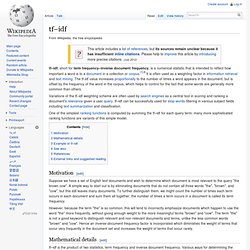

Latent semantic indexing. Latent semantic indexing (LSI) is an indexing and retrieval method that uses a mathematical technique called singular value decomposition (SVD) to identify patterns in the relationships between the terms and concepts contained in an unstructured collection of text.

LSI is based on the principle that words that are used in the same contexts tend to have similar meanings. A key feature of LSI is its ability to extract the conceptual content of a body of text by establishing associations between those terms that occur in similar contexts.[1] LSI is also an application of correspondence analysis, a multivariate statistical technique developed by Jean-Paul Benzécri[2] in the early 1970s, to a contingency table built from word counts in documents.
Called Latent Semantic Indexing because of its ability to correlate semantically related terms that are latent in a collection of text, it was first applied to text at Bell Laboratories in the late 1980s. Benefits of LSI[edit] LSI timeline[edit] . Part-of-speech tagging. Once performed by hand, POS tagging is now done in the context of computational linguistics, using algorithms which associate discrete terms, as well as hidden parts of speech, in accordance with a set of descriptive tags.

POS-tagging algorithms fall into two distinctive groups: rule-based and stochastic. E. Brill's tagger, one of the first and most widely used English POS-taggers, employs rule-based algorithms. Principle[edit] Part-of-speech tagging is harder than just having a list of words and their parts of speech, because some words can represent more than one part of speech at different times, and because some parts of speech are complex or unspoken. The sailor dogs the hatch. Correct grammatical tagging will reflect that "dogs" is here used as a verb, not as the more common plural noun.
In part-of-speech tagging by computer, it is typical to distinguish from 50 to 150 separate parts of speech for English. History[edit] The Brown Corpus[edit] Use of Hidden Markov Models[edit] Tf–idf. One of the simplest ranking functions is computed by summing the tf–idf for each query term; many more sophisticated ranking functions are variants of this simple model.

Motivation[edit] Suppose we have a set of English text documents and wish to determine which document is most relevant to the query "the brown cow". A simple way to start out is by eliminating documents that do not contain all three words "the", "brown", and "cow", but this still leaves many documents. To further distinguish them, we might count the number of times each term occurs in each document and sum them all together; the number of times a term occurs in a document is called its term frequency.
However, because the term "the" is so common, this will tend to incorrectly emphasize documents which happen to use the word "the" more frequently, without giving enough weight to the more meaningful terms "brown" and "cow". Mathematical details[edit] with Then tf–idf is calculated as Example of tf–idf[edit] See also[edit]